Workplace Bullying in the Nursing Sector
VerifiedAdded on 2023/06/04
|16
|4865
|177
AI Summary
This journal focuses on relevant studies on the reflection of workplace bullying, including the identification, causes, and prevalence within the nursing field. Also, the report describes the various types of bullying and their effects on the victim. The report then indicates the combating strategies, prevention and how to handle the problem.
Contribute Materials
Your contribution can guide someone’s learning journey. Share your
documents today.
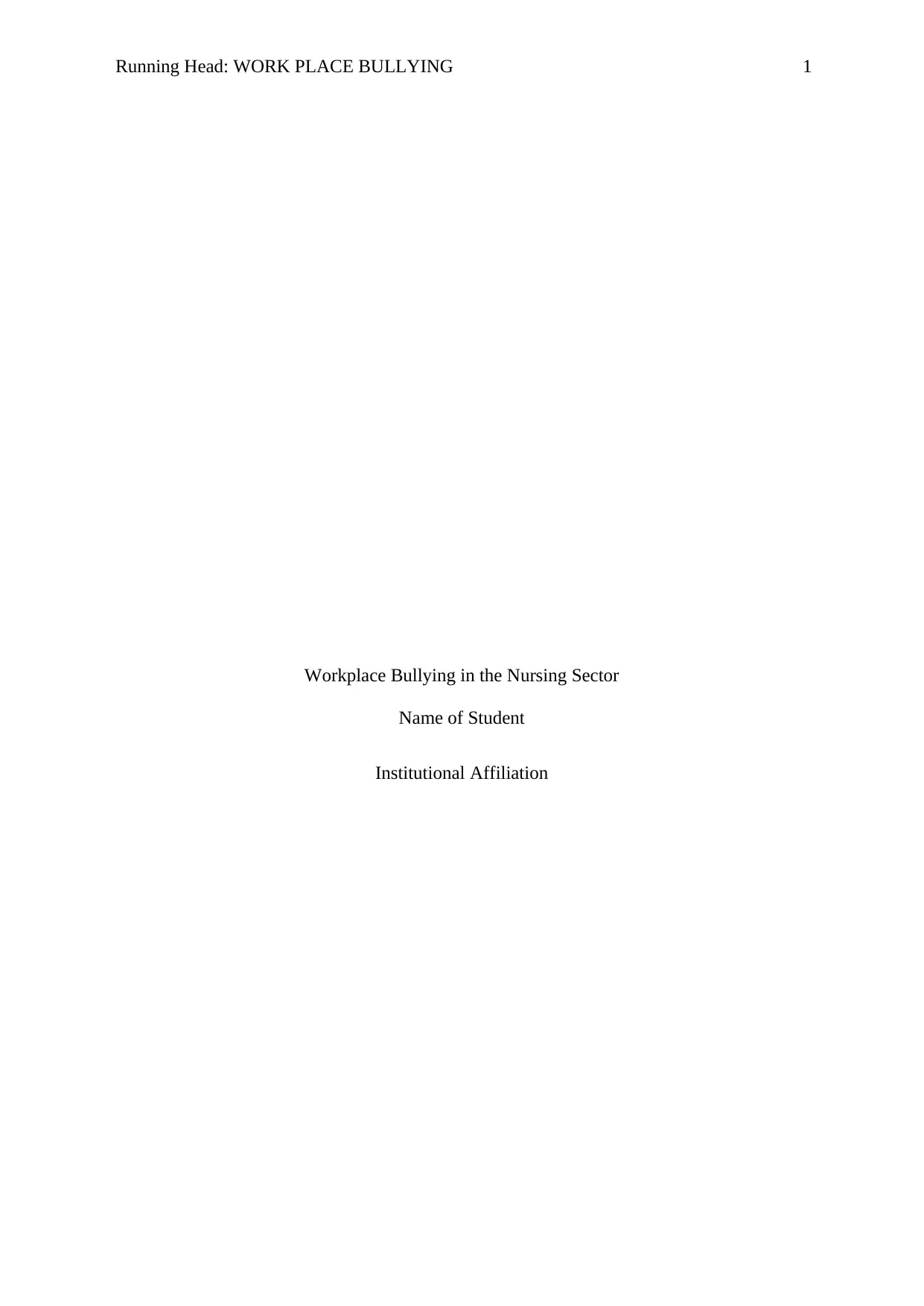
Running Head: WORK PLACE BULLYING 1
Workplace Bullying in the Nursing Sector
Name of Student
Institutional Affiliation
Workplace Bullying in the Nursing Sector
Name of Student
Institutional Affiliation
Secure Best Marks with AI Grader
Need help grading? Try our AI Grader for instant feedback on your assignments.
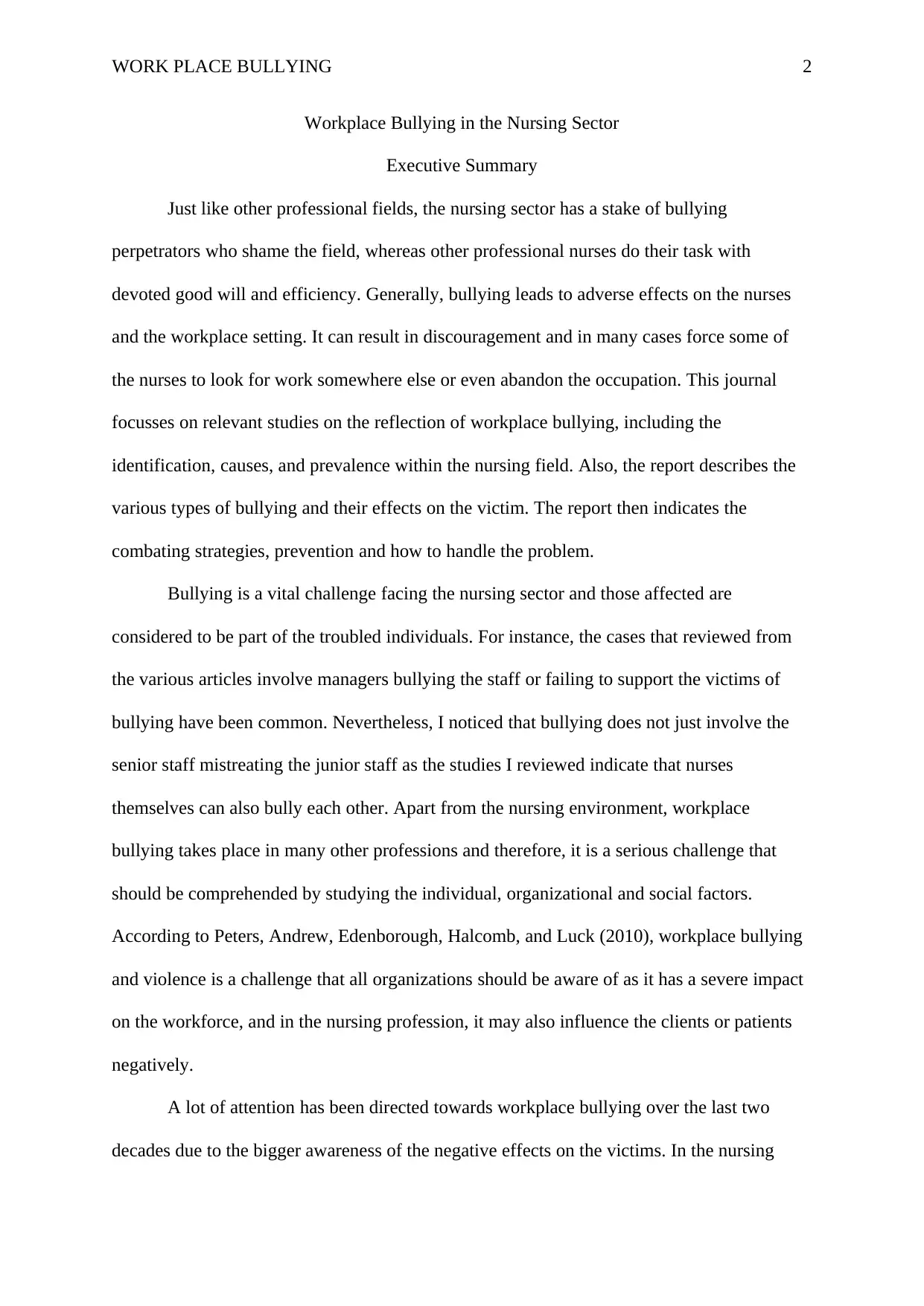
WORK PLACE BULLYING 2
Workplace Bullying in the Nursing Sector
Executive Summary
Just like other professional fields, the nursing sector has a stake of bullying
perpetrators who shame the field, whereas other professional nurses do their task with
devoted good will and efficiency. Generally, bullying leads to adverse effects on the nurses
and the workplace setting. It can result in discouragement and in many cases force some of
the nurses to look for work somewhere else or even abandon the occupation. This journal
focusses on relevant studies on the reflection of workplace bullying, including the
identification, causes, and prevalence within the nursing field. Also, the report describes the
various types of bullying and their effects on the victim. The report then indicates the
combating strategies, prevention and how to handle the problem.
Bullying is a vital challenge facing the nursing sector and those affected are
considered to be part of the troubled individuals. For instance, the cases that reviewed from
the various articles involve managers bullying the staff or failing to support the victims of
bullying have been common. Nevertheless, I noticed that bullying does not just involve the
senior staff mistreating the junior staff as the studies I reviewed indicate that nurses
themselves can also bully each other. Apart from the nursing environment, workplace
bullying takes place in many other professions and therefore, it is a serious challenge that
should be comprehended by studying the individual, organizational and social factors.
According to Peters, Andrew, Edenborough, Halcomb, and Luck (2010), workplace bullying
and violence is a challenge that all organizations should be aware of as it has a severe impact
on the workforce, and in the nursing profession, it may also influence the clients or patients
negatively.
A lot of attention has been directed towards workplace bullying over the last two
decades due to the bigger awareness of the negative effects on the victims. In the nursing
Workplace Bullying in the Nursing Sector
Executive Summary
Just like other professional fields, the nursing sector has a stake of bullying
perpetrators who shame the field, whereas other professional nurses do their task with
devoted good will and efficiency. Generally, bullying leads to adverse effects on the nurses
and the workplace setting. It can result in discouragement and in many cases force some of
the nurses to look for work somewhere else or even abandon the occupation. This journal
focusses on relevant studies on the reflection of workplace bullying, including the
identification, causes, and prevalence within the nursing field. Also, the report describes the
various types of bullying and their effects on the victim. The report then indicates the
combating strategies, prevention and how to handle the problem.
Bullying is a vital challenge facing the nursing sector and those affected are
considered to be part of the troubled individuals. For instance, the cases that reviewed from
the various articles involve managers bullying the staff or failing to support the victims of
bullying have been common. Nevertheless, I noticed that bullying does not just involve the
senior staff mistreating the junior staff as the studies I reviewed indicate that nurses
themselves can also bully each other. Apart from the nursing environment, workplace
bullying takes place in many other professions and therefore, it is a serious challenge that
should be comprehended by studying the individual, organizational and social factors.
According to Peters, Andrew, Edenborough, Halcomb, and Luck (2010), workplace bullying
and violence is a challenge that all organizations should be aware of as it has a severe impact
on the workforce, and in the nursing profession, it may also influence the clients or patients
negatively.
A lot of attention has been directed towards workplace bullying over the last two
decades due to the bigger awareness of the negative effects on the victims. In the nursing
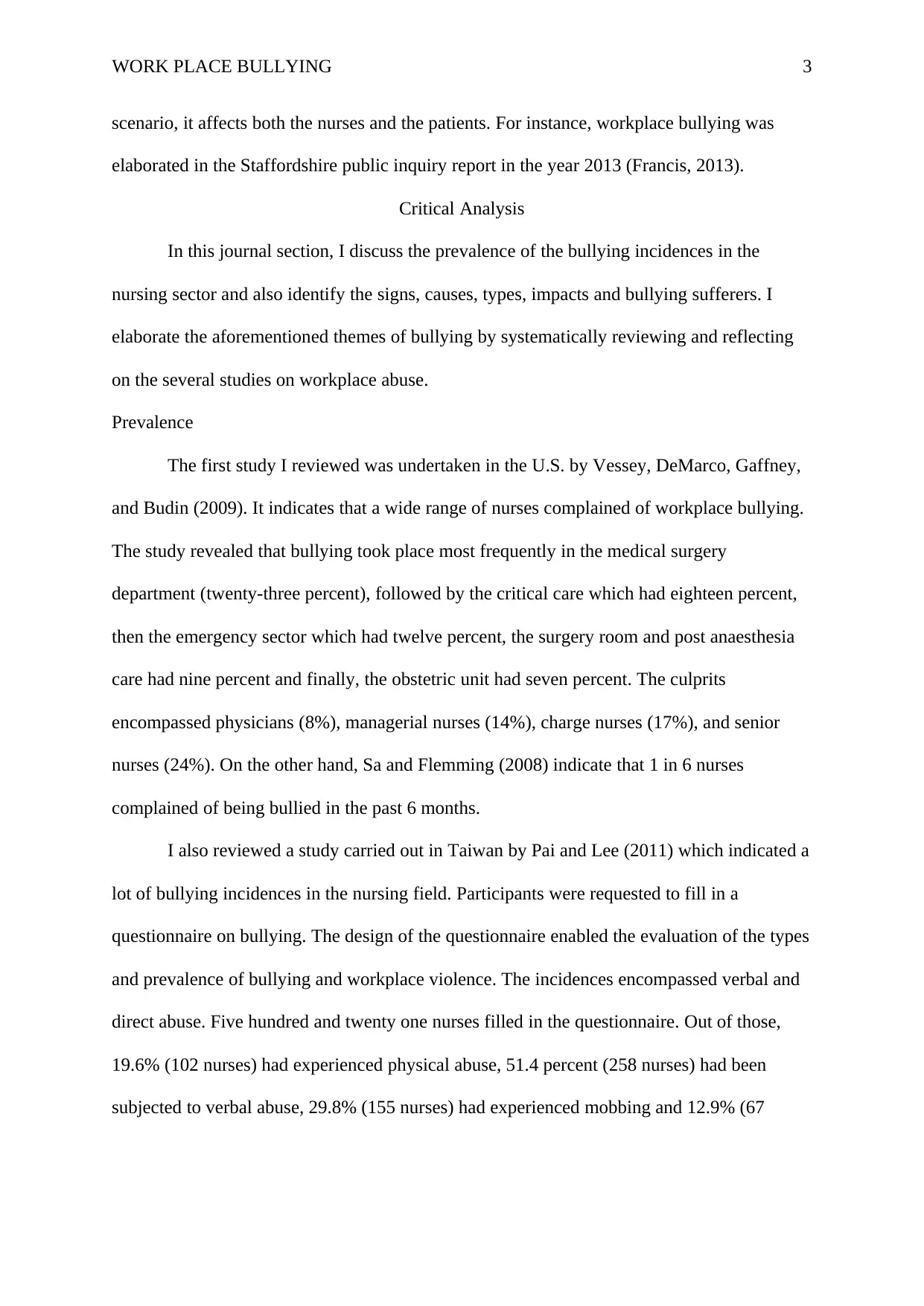
WORK PLACE BULLYING 3
scenario, it affects both the nurses and the patients. For instance, workplace bullying was
elaborated in the Staffordshire public inquiry report in the year 2013 (Francis, 2013).
Critical Analysis
In this journal section, I discuss the prevalence of the bullying incidences in the
nursing sector and also identify the signs, causes, types, impacts and bullying sufferers. I
elaborate the aforementioned themes of bullying by systematically reviewing and reflecting
on the several studies on workplace abuse.
Prevalence
The first study I reviewed was undertaken in the U.S. by Vessey, DeMarco, Gaffney,
and Budin (2009). It indicates that a wide range of nurses complained of workplace bullying.
The study revealed that bullying took place most frequently in the medical surgery
department (twenty-three percent), followed by the critical care which had eighteen percent,
then the emergency sector which had twelve percent, the surgery room and post anaesthesia
care had nine percent and finally, the obstetric unit had seven percent. The culprits
encompassed physicians (8%), managerial nurses (14%), charge nurses (17%), and senior
nurses (24%). On the other hand, Sa and Flemming (2008) indicate that 1 in 6 nurses
complained of being bullied in the past 6 months.
I also reviewed a study carried out in Taiwan by Pai and Lee (2011) which indicated a
lot of bullying incidences in the nursing field. Participants were requested to fill in a
questionnaire on bullying. The design of the questionnaire enabled the evaluation of the types
and prevalence of bullying and workplace violence. The incidences encompassed verbal and
direct abuse. Five hundred and twenty one nurses filled in the questionnaire. Out of those,
19.6% (102 nurses) had experienced physical abuse, 51.4 percent (258 nurses) had been
subjected to verbal abuse, 29.8% (155 nurses) had experienced mobbing and 12.9% (67
scenario, it affects both the nurses and the patients. For instance, workplace bullying was
elaborated in the Staffordshire public inquiry report in the year 2013 (Francis, 2013).
Critical Analysis
In this journal section, I discuss the prevalence of the bullying incidences in the
nursing sector and also identify the signs, causes, types, impacts and bullying sufferers. I
elaborate the aforementioned themes of bullying by systematically reviewing and reflecting
on the several studies on workplace abuse.
Prevalence
The first study I reviewed was undertaken in the U.S. by Vessey, DeMarco, Gaffney,
and Budin (2009). It indicates that a wide range of nurses complained of workplace bullying.
The study revealed that bullying took place most frequently in the medical surgery
department (twenty-three percent), followed by the critical care which had eighteen percent,
then the emergency sector which had twelve percent, the surgery room and post anaesthesia
care had nine percent and finally, the obstetric unit had seven percent. The culprits
encompassed physicians (8%), managerial nurses (14%), charge nurses (17%), and senior
nurses (24%). On the other hand, Sa and Flemming (2008) indicate that 1 in 6 nurses
complained of being bullied in the past 6 months.
I also reviewed a study carried out in Taiwan by Pai and Lee (2011) which indicated a
lot of bullying incidences in the nursing field. Participants were requested to fill in a
questionnaire on bullying. The design of the questionnaire enabled the evaluation of the types
and prevalence of bullying and workplace violence. The incidences encompassed verbal and
direct abuse. Five hundred and twenty one nurses filled in the questionnaire. Out of those,
19.6% (102 nurses) had experienced physical abuse, 51.4 percent (258 nurses) had been
subjected to verbal abuse, 29.8% (155 nurses) had experienced mobbing and 12.9% (67
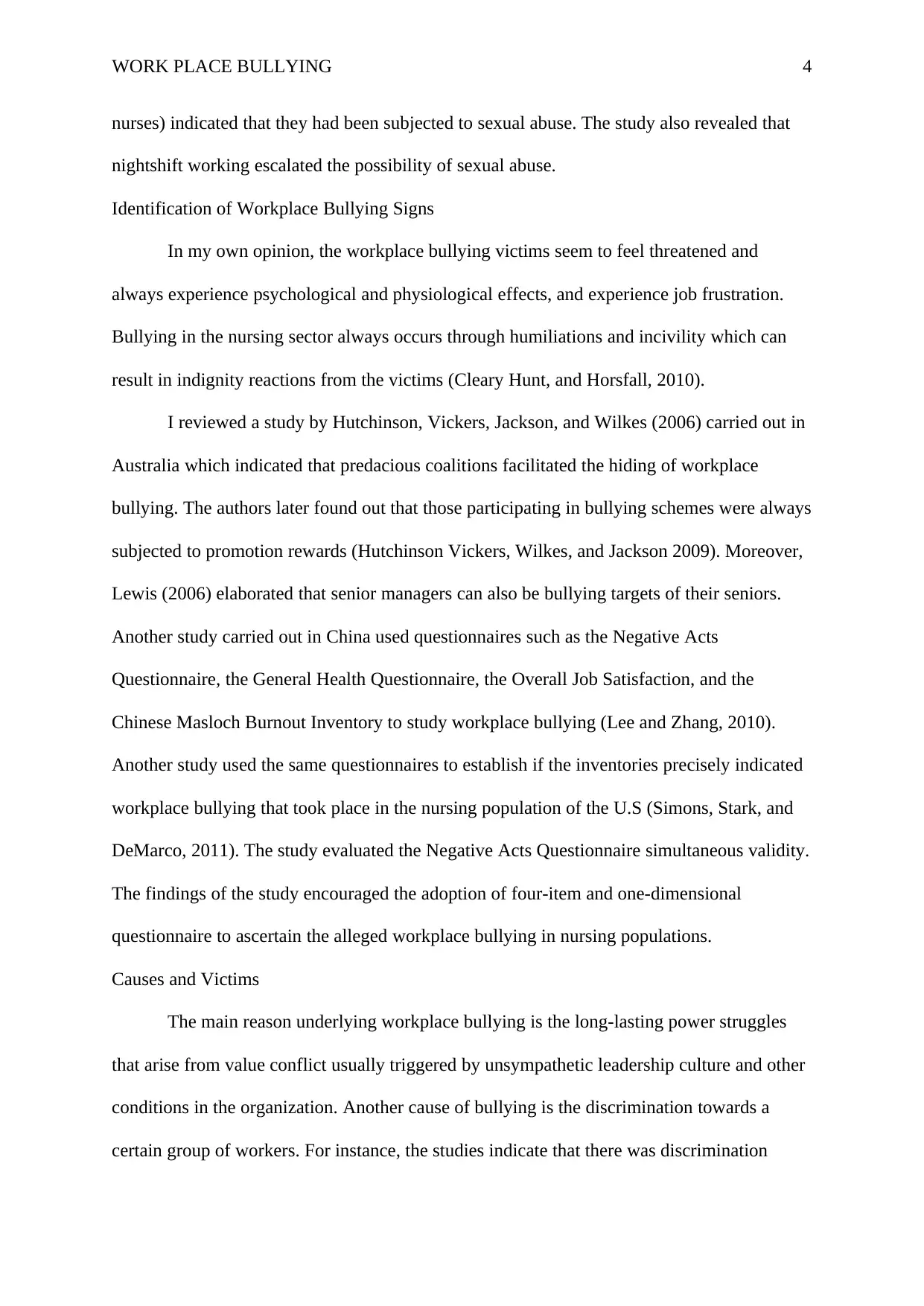
WORK PLACE BULLYING 4
nurses) indicated that they had been subjected to sexual abuse. The study also revealed that
nightshift working escalated the possibility of sexual abuse.
Identification of Workplace Bullying Signs
In my own opinion, the workplace bullying victims seem to feel threatened and
always experience psychological and physiological effects, and experience job frustration.
Bullying in the nursing sector always occurs through humiliations and incivility which can
result in indignity reactions from the victims (Cleary Hunt, and Horsfall, 2010).
I reviewed a study by Hutchinson, Vickers, Jackson, and Wilkes (2006) carried out in
Australia which indicated that predacious coalitions facilitated the hiding of workplace
bullying. The authors later found out that those participating in bullying schemes were always
subjected to promotion rewards (Hutchinson Vickers, Wilkes, and Jackson 2009). Moreover,
Lewis (2006) elaborated that senior managers can also be bullying targets of their seniors.
Another study carried out in China used questionnaires such as the Negative Acts
Questionnaire, the General Health Questionnaire, the Overall Job Satisfaction, and the
Chinese Masloch Burnout Inventory to study workplace bullying (Lee and Zhang, 2010).
Another study used the same questionnaires to establish if the inventories precisely indicated
workplace bullying that took place in the nursing population of the U.S (Simons, Stark, and
DeMarco, 2011). The study evaluated the Negative Acts Questionnaire simultaneous validity.
The findings of the study encouraged the adoption of four-item and one-dimensional
questionnaire to ascertain the alleged workplace bullying in nursing populations.
Causes and Victims
The main reason underlying workplace bullying is the long-lasting power struggles
that arise from value conflict usually triggered by unsympathetic leadership culture and other
conditions in the organization. Another cause of bullying is the discrimination towards a
certain group of workers. For instance, the studies indicate that there was discrimination
nurses) indicated that they had been subjected to sexual abuse. The study also revealed that
nightshift working escalated the possibility of sexual abuse.
Identification of Workplace Bullying Signs
In my own opinion, the workplace bullying victims seem to feel threatened and
always experience psychological and physiological effects, and experience job frustration.
Bullying in the nursing sector always occurs through humiliations and incivility which can
result in indignity reactions from the victims (Cleary Hunt, and Horsfall, 2010).
I reviewed a study by Hutchinson, Vickers, Jackson, and Wilkes (2006) carried out in
Australia which indicated that predacious coalitions facilitated the hiding of workplace
bullying. The authors later found out that those participating in bullying schemes were always
subjected to promotion rewards (Hutchinson Vickers, Wilkes, and Jackson 2009). Moreover,
Lewis (2006) elaborated that senior managers can also be bullying targets of their seniors.
Another study carried out in China used questionnaires such as the Negative Acts
Questionnaire, the General Health Questionnaire, the Overall Job Satisfaction, and the
Chinese Masloch Burnout Inventory to study workplace bullying (Lee and Zhang, 2010).
Another study used the same questionnaires to establish if the inventories precisely indicated
workplace bullying that took place in the nursing population of the U.S (Simons, Stark, and
DeMarco, 2011). The study evaluated the Negative Acts Questionnaire simultaneous validity.
The findings of the study encouraged the adoption of four-item and one-dimensional
questionnaire to ascertain the alleged workplace bullying in nursing populations.
Causes and Victims
The main reason underlying workplace bullying is the long-lasting power struggles
that arise from value conflict usually triggered by unsympathetic leadership culture and other
conditions in the organization. Another cause of bullying is the discrimination towards a
certain group of workers. For instance, the studies indicate that there was discrimination
Secure Best Marks with AI Grader
Need help grading? Try our AI Grader for instant feedback on your assignments.

WORK PLACE BULLYING 5
towards the foreign-trained nurses hired to work in the United Kingdom. Thus, the studies
suggest that racism can at times become embedded in the working environment of nurses
(Hogh, Carneiro, Giver, and Rugulies, 2011). Hogh et al. (2011) also indicated that
immigrant nurses who did not have western backgrounds had were more vulnerable to
workplace bullying especially during their training period and the first years of employment.
Basing on Katrinli, Atabay, Gunay, and Cangarli (2010), I learned that political
factors can also be a reasons underlying workplace bullying as they can serve the self-
interests of the culprits. The reason behind political influence being the need for promotional
competition and power (Katrinli et al., 2010). For instance, a Canadian study by Laschinger,
Grau, Finegan, and Wilk (2010) indicated that it was very common for old nurses to bully the
graduate nurses. Another research by Huntington et al. (2011) associated bullying with the
escalating work pressure and factors in the organization that encompassed non-provision of
support from the management. The study also elaborated that bullying in a nursing workplace
can be integrated into the informal organizational links. Moreover, Hutchinson et al. (2010)
revealed that it is very hard to identify workplace bullying because it is always linked to the
entire organization. Therefore, organizational factors can heavily affect both the possibility of
bullying occurrences and whether such incidences can be rectified. Ideally, nurses always
find it challenging to complain when it comes to the impact of bullying. Whistleblowing may
at times be perceived as a revenge process (Jackson et al., 2010).
Workplace Bullying Types
In this section, I base on the reviewed articles to discuss the four main types of
bullying which encompass racism, sexual harassment, intimidation or blackmail, and cyber-
bullying.
First, Cleary Hunt, and Horsfall (2010) documented racism, discrimination and
workplace bullying of nurses trained from overseas and immigrant nurses. They clarify that
towards the foreign-trained nurses hired to work in the United Kingdom. Thus, the studies
suggest that racism can at times become embedded in the working environment of nurses
(Hogh, Carneiro, Giver, and Rugulies, 2011). Hogh et al. (2011) also indicated that
immigrant nurses who did not have western backgrounds had were more vulnerable to
workplace bullying especially during their training period and the first years of employment.
Basing on Katrinli, Atabay, Gunay, and Cangarli (2010), I learned that political
factors can also be a reasons underlying workplace bullying as they can serve the self-
interests of the culprits. The reason behind political influence being the need for promotional
competition and power (Katrinli et al., 2010). For instance, a Canadian study by Laschinger,
Grau, Finegan, and Wilk (2010) indicated that it was very common for old nurses to bully the
graduate nurses. Another research by Huntington et al. (2011) associated bullying with the
escalating work pressure and factors in the organization that encompassed non-provision of
support from the management. The study also elaborated that bullying in a nursing workplace
can be integrated into the informal organizational links. Moreover, Hutchinson et al. (2010)
revealed that it is very hard to identify workplace bullying because it is always linked to the
entire organization. Therefore, organizational factors can heavily affect both the possibility of
bullying occurrences and whether such incidences can be rectified. Ideally, nurses always
find it challenging to complain when it comes to the impact of bullying. Whistleblowing may
at times be perceived as a revenge process (Jackson et al., 2010).
Workplace Bullying Types
In this section, I base on the reviewed articles to discuss the four main types of
bullying which encompass racism, sexual harassment, intimidation or blackmail, and cyber-
bullying.
First, Cleary Hunt, and Horsfall (2010) documented racism, discrimination and
workplace bullying of nurses trained from overseas and immigrant nurses. They clarify that
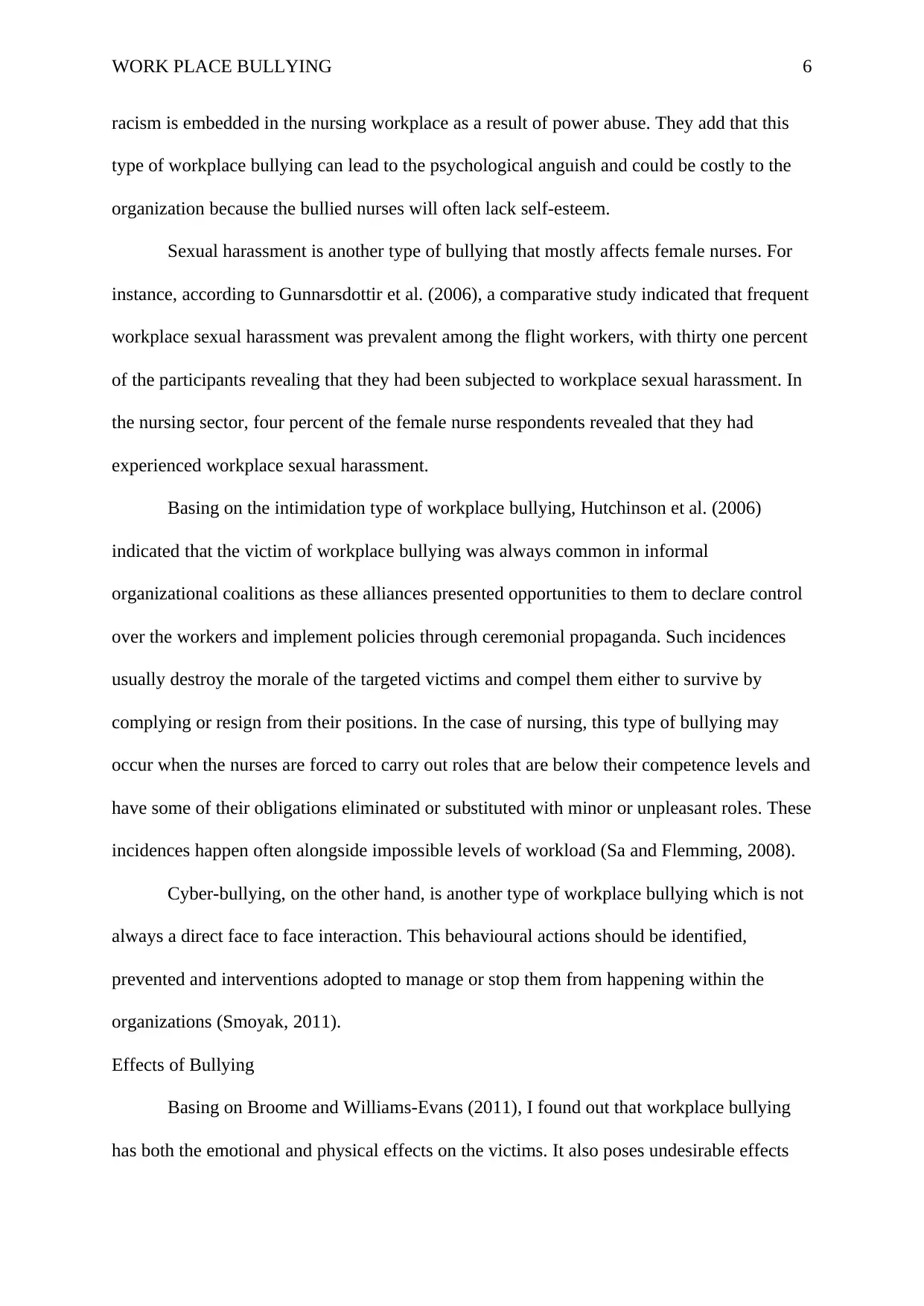
WORK PLACE BULLYING 6
racism is embedded in the nursing workplace as a result of power abuse. They add that this
type of workplace bullying can lead to the psychological anguish and could be costly to the
organization because the bullied nurses will often lack self-esteem.
Sexual harassment is another type of bullying that mostly affects female nurses. For
instance, according to Gunnarsdottir et al. (2006), a comparative study indicated that frequent
workplace sexual harassment was prevalent among the flight workers, with thirty one percent
of the participants revealing that they had been subjected to workplace sexual harassment. In
the nursing sector, four percent of the female nurse respondents revealed that they had
experienced workplace sexual harassment.
Basing on the intimidation type of workplace bullying, Hutchinson et al. (2006)
indicated that the victim of workplace bullying was always common in informal
organizational coalitions as these alliances presented opportunities to them to declare control
over the workers and implement policies through ceremonial propaganda. Such incidences
usually destroy the morale of the targeted victims and compel them either to survive by
complying or resign from their positions. In the case of nursing, this type of bullying may
occur when the nurses are forced to carry out roles that are below their competence levels and
have some of their obligations eliminated or substituted with minor or unpleasant roles. These
incidences happen often alongside impossible levels of workload (Sa and Flemming, 2008).
Cyber-bullying, on the other hand, is another type of workplace bullying which is not
always a direct face to face interaction. This behavioural actions should be identified,
prevented and interventions adopted to manage or stop them from happening within the
organizations (Smoyak, 2011).
Effects of Bullying
Basing on Broome and Williams-Evans (2011), I found out that workplace bullying
has both the emotional and physical effects on the victims. It also poses undesirable effects
racism is embedded in the nursing workplace as a result of power abuse. They add that this
type of workplace bullying can lead to the psychological anguish and could be costly to the
organization because the bullied nurses will often lack self-esteem.
Sexual harassment is another type of bullying that mostly affects female nurses. For
instance, according to Gunnarsdottir et al. (2006), a comparative study indicated that frequent
workplace sexual harassment was prevalent among the flight workers, with thirty one percent
of the participants revealing that they had been subjected to workplace sexual harassment. In
the nursing sector, four percent of the female nurse respondents revealed that they had
experienced workplace sexual harassment.
Basing on the intimidation type of workplace bullying, Hutchinson et al. (2006)
indicated that the victim of workplace bullying was always common in informal
organizational coalitions as these alliances presented opportunities to them to declare control
over the workers and implement policies through ceremonial propaganda. Such incidences
usually destroy the morale of the targeted victims and compel them either to survive by
complying or resign from their positions. In the case of nursing, this type of bullying may
occur when the nurses are forced to carry out roles that are below their competence levels and
have some of their obligations eliminated or substituted with minor or unpleasant roles. These
incidences happen often alongside impossible levels of workload (Sa and Flemming, 2008).
Cyber-bullying, on the other hand, is another type of workplace bullying which is not
always a direct face to face interaction. This behavioural actions should be identified,
prevented and interventions adopted to manage or stop them from happening within the
organizations (Smoyak, 2011).
Effects of Bullying
Basing on Broome and Williams-Evans (2011), I found out that workplace bullying
has both the emotional and physical effects on the victims. It also poses undesirable effects
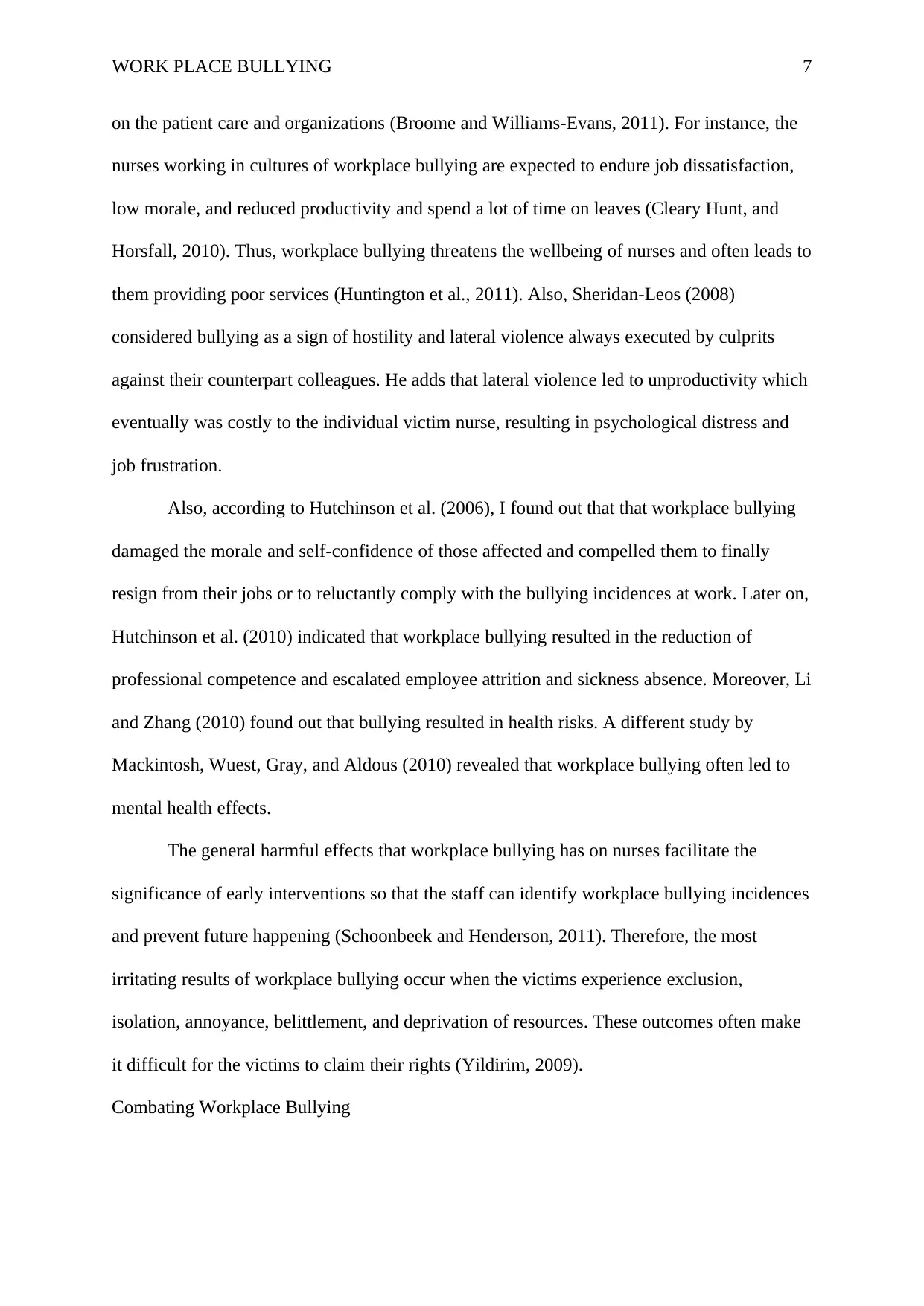
WORK PLACE BULLYING 7
on the patient care and organizations (Broome and Williams-Evans, 2011). For instance, the
nurses working in cultures of workplace bullying are expected to endure job dissatisfaction,
low morale, and reduced productivity and spend a lot of time on leaves (Cleary Hunt, and
Horsfall, 2010). Thus, workplace bullying threatens the wellbeing of nurses and often leads to
them providing poor services (Huntington et al., 2011). Also, Sheridan-Leos (2008)
considered bullying as a sign of hostility and lateral violence always executed by culprits
against their counterpart colleagues. He adds that lateral violence led to unproductivity which
eventually was costly to the individual victim nurse, resulting in psychological distress and
job frustration.
Also, according to Hutchinson et al. (2006), I found out that that workplace bullying
damaged the morale and self-confidence of those affected and compelled them to finally
resign from their jobs or to reluctantly comply with the bullying incidences at work. Later on,
Hutchinson et al. (2010) indicated that workplace bullying resulted in the reduction of
professional competence and escalated employee attrition and sickness absence. Moreover, Li
and Zhang (2010) found out that bullying resulted in health risks. A different study by
Mackintosh, Wuest, Gray, and Aldous (2010) revealed that workplace bullying often led to
mental health effects.
The general harmful effects that workplace bullying has on nurses facilitate the
significance of early interventions so that the staff can identify workplace bullying incidences
and prevent future happening (Schoonbeek and Henderson, 2011). Therefore, the most
irritating results of workplace bullying occur when the victims experience exclusion,
isolation, annoyance, belittlement, and deprivation of resources. These outcomes often make
it difficult for the victims to claim their rights (Yildirim, 2009).
Combating Workplace Bullying
on the patient care and organizations (Broome and Williams-Evans, 2011). For instance, the
nurses working in cultures of workplace bullying are expected to endure job dissatisfaction,
low morale, and reduced productivity and spend a lot of time on leaves (Cleary Hunt, and
Horsfall, 2010). Thus, workplace bullying threatens the wellbeing of nurses and often leads to
them providing poor services (Huntington et al., 2011). Also, Sheridan-Leos (2008)
considered bullying as a sign of hostility and lateral violence always executed by culprits
against their counterpart colleagues. He adds that lateral violence led to unproductivity which
eventually was costly to the individual victim nurse, resulting in psychological distress and
job frustration.
Also, according to Hutchinson et al. (2006), I found out that that workplace bullying
damaged the morale and self-confidence of those affected and compelled them to finally
resign from their jobs or to reluctantly comply with the bullying incidences at work. Later on,
Hutchinson et al. (2010) indicated that workplace bullying resulted in the reduction of
professional competence and escalated employee attrition and sickness absence. Moreover, Li
and Zhang (2010) found out that bullying resulted in health risks. A different study by
Mackintosh, Wuest, Gray, and Aldous (2010) revealed that workplace bullying often led to
mental health effects.
The general harmful effects that workplace bullying has on nurses facilitate the
significance of early interventions so that the staff can identify workplace bullying incidences
and prevent future happening (Schoonbeek and Henderson, 2011). Therefore, the most
irritating results of workplace bullying occur when the victims experience exclusion,
isolation, annoyance, belittlement, and deprivation of resources. These outcomes often make
it difficult for the victims to claim their rights (Yildirim, 2009).
Combating Workplace Bullying
Paraphrase This Document
Need a fresh take? Get an instant paraphrase of this document with our AI Paraphraser
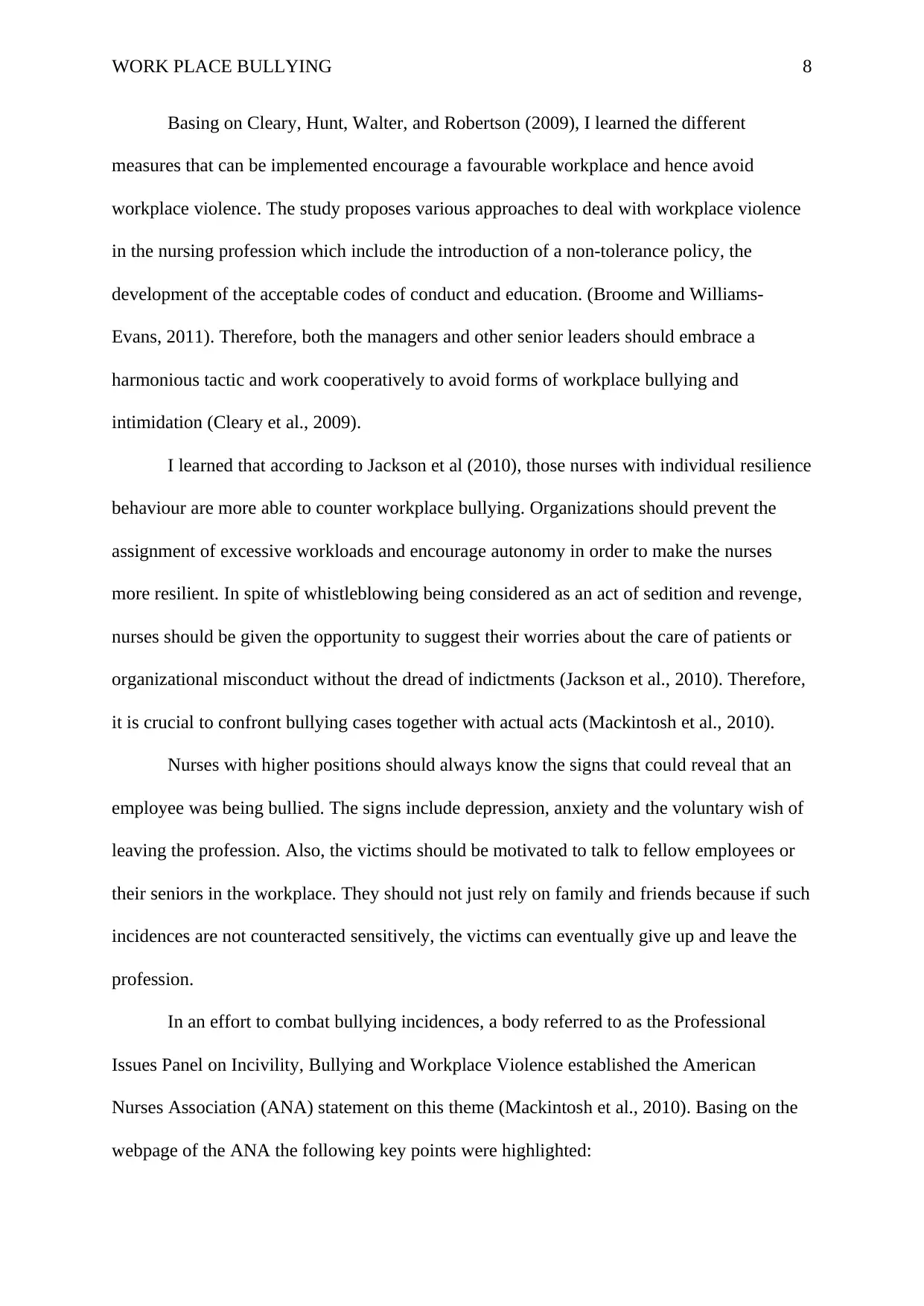
WORK PLACE BULLYING 8
Basing on Cleary, Hunt, Walter, and Robertson (2009), I learned the different
measures that can be implemented encourage a favourable workplace and hence avoid
workplace violence. The study proposes various approaches to deal with workplace violence
in the nursing profession which include the introduction of a non-tolerance policy, the
development of the acceptable codes of conduct and education. (Broome and Williams-
Evans, 2011). Therefore, both the managers and other senior leaders should embrace a
harmonious tactic and work cooperatively to avoid forms of workplace bullying and
intimidation (Cleary et al., 2009).
I learned that according to Jackson et al (2010), those nurses with individual resilience
behaviour are more able to counter workplace bullying. Organizations should prevent the
assignment of excessive workloads and encourage autonomy in order to make the nurses
more resilient. In spite of whistleblowing being considered as an act of sedition and revenge,
nurses should be given the opportunity to suggest their worries about the care of patients or
organizational misconduct without the dread of indictments (Jackson et al., 2010). Therefore,
it is crucial to confront bullying cases together with actual acts (Mackintosh et al., 2010).
Nurses with higher positions should always know the signs that could reveal that an
employee was being bullied. The signs include depression, anxiety and the voluntary wish of
leaving the profession. Also, the victims should be motivated to talk to fellow employees or
their seniors in the workplace. They should not just rely on family and friends because if such
incidences are not counteracted sensitively, the victims can eventually give up and leave the
profession.
In an effort to combat bullying incidences, a body referred to as the Professional
Issues Panel on Incivility, Bullying and Workplace Violence established the American
Nurses Association (ANA) statement on this theme (Mackintosh et al., 2010). Basing on the
webpage of the ANA the following key points were highlighted:
Basing on Cleary, Hunt, Walter, and Robertson (2009), I learned the different
measures that can be implemented encourage a favourable workplace and hence avoid
workplace violence. The study proposes various approaches to deal with workplace violence
in the nursing profession which include the introduction of a non-tolerance policy, the
development of the acceptable codes of conduct and education. (Broome and Williams-
Evans, 2011). Therefore, both the managers and other senior leaders should embrace a
harmonious tactic and work cooperatively to avoid forms of workplace bullying and
intimidation (Cleary et al., 2009).
I learned that according to Jackson et al (2010), those nurses with individual resilience
behaviour are more able to counter workplace bullying. Organizations should prevent the
assignment of excessive workloads and encourage autonomy in order to make the nurses
more resilient. In spite of whistleblowing being considered as an act of sedition and revenge,
nurses should be given the opportunity to suggest their worries about the care of patients or
organizational misconduct without the dread of indictments (Jackson et al., 2010). Therefore,
it is crucial to confront bullying cases together with actual acts (Mackintosh et al., 2010).
Nurses with higher positions should always know the signs that could reveal that an
employee was being bullied. The signs include depression, anxiety and the voluntary wish of
leaving the profession. Also, the victims should be motivated to talk to fellow employees or
their seniors in the workplace. They should not just rely on family and friends because if such
incidences are not counteracted sensitively, the victims can eventually give up and leave the
profession.
In an effort to combat bullying incidences, a body referred to as the Professional
Issues Panel on Incivility, Bullying and Workplace Violence established the American
Nurses Association (ANA) statement on this theme (Mackintosh et al., 2010). Basing on the
webpage of the ANA the following key points were highlighted:
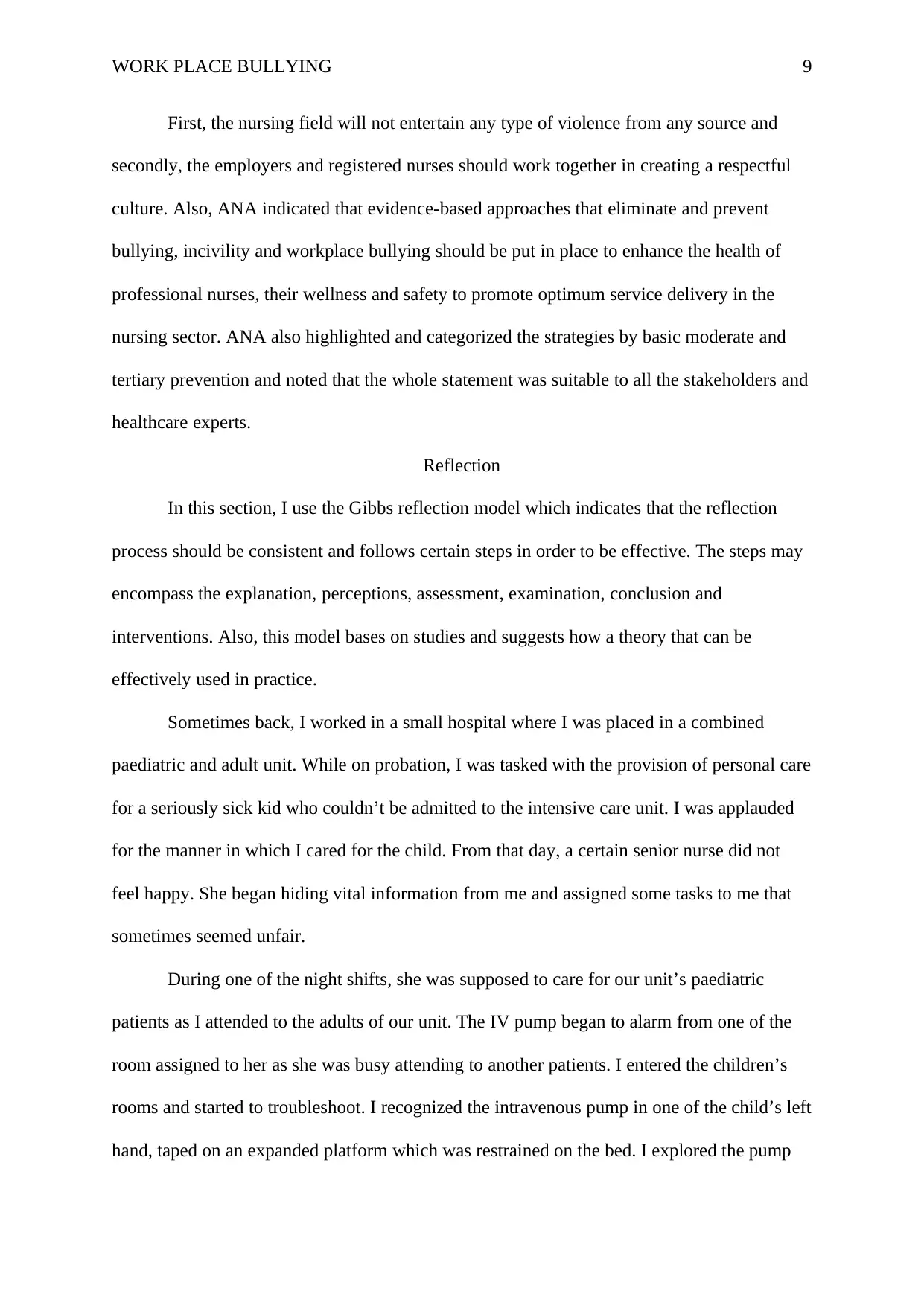
WORK PLACE BULLYING 9
First, the nursing field will not entertain any type of violence from any source and
secondly, the employers and registered nurses should work together in creating a respectful
culture. Also, ANA indicated that evidence-based approaches that eliminate and prevent
bullying, incivility and workplace bullying should be put in place to enhance the health of
professional nurses, their wellness and safety to promote optimum service delivery in the
nursing sector. ANA also highlighted and categorized the strategies by basic moderate and
tertiary prevention and noted that the whole statement was suitable to all the stakeholders and
healthcare experts.
Reflection
In this section, I use the Gibbs reflection model which indicates that the reflection
process should be consistent and follows certain steps in order to be effective. The steps may
encompass the explanation, perceptions, assessment, examination, conclusion and
interventions. Also, this model bases on studies and suggests how a theory that can be
effectively used in practice.
Sometimes back, I worked in a small hospital where I was placed in a combined
paediatric and adult unit. While on probation, I was tasked with the provision of personal care
for a seriously sick kid who couldn’t be admitted to the intensive care unit. I was applauded
for the manner in which I cared for the child. From that day, a certain senior nurse did not
feel happy. She began hiding vital information from me and assigned some tasks to me that
sometimes seemed unfair.
During one of the night shifts, she was supposed to care for our unit’s paediatric
patients as I attended to the adults of our unit. The IV pump began to alarm from one of the
room assigned to her as she was busy attending to another patients. I entered the children’s
rooms and started to troubleshoot. I recognized the intravenous pump in one of the child’s left
hand, taped on an expanded platform which was restrained on the bed. I explored the pump
First, the nursing field will not entertain any type of violence from any source and
secondly, the employers and registered nurses should work together in creating a respectful
culture. Also, ANA indicated that evidence-based approaches that eliminate and prevent
bullying, incivility and workplace bullying should be put in place to enhance the health of
professional nurses, their wellness and safety to promote optimum service delivery in the
nursing sector. ANA also highlighted and categorized the strategies by basic moderate and
tertiary prevention and noted that the whole statement was suitable to all the stakeholders and
healthcare experts.
Reflection
In this section, I use the Gibbs reflection model which indicates that the reflection
process should be consistent and follows certain steps in order to be effective. The steps may
encompass the explanation, perceptions, assessment, examination, conclusion and
interventions. Also, this model bases on studies and suggests how a theory that can be
effectively used in practice.
Sometimes back, I worked in a small hospital where I was placed in a combined
paediatric and adult unit. While on probation, I was tasked with the provision of personal care
for a seriously sick kid who couldn’t be admitted to the intensive care unit. I was applauded
for the manner in which I cared for the child. From that day, a certain senior nurse did not
feel happy. She began hiding vital information from me and assigned some tasks to me that
sometimes seemed unfair.
During one of the night shifts, she was supposed to care for our unit’s paediatric
patients as I attended to the adults of our unit. The IV pump began to alarm from one of the
room assigned to her as she was busy attending to another patients. I entered the children’s
rooms and started to troubleshoot. I recognized the intravenous pump in one of the child’s left
hand, taped on an expanded platform which was restrained on the bed. I explored the pump
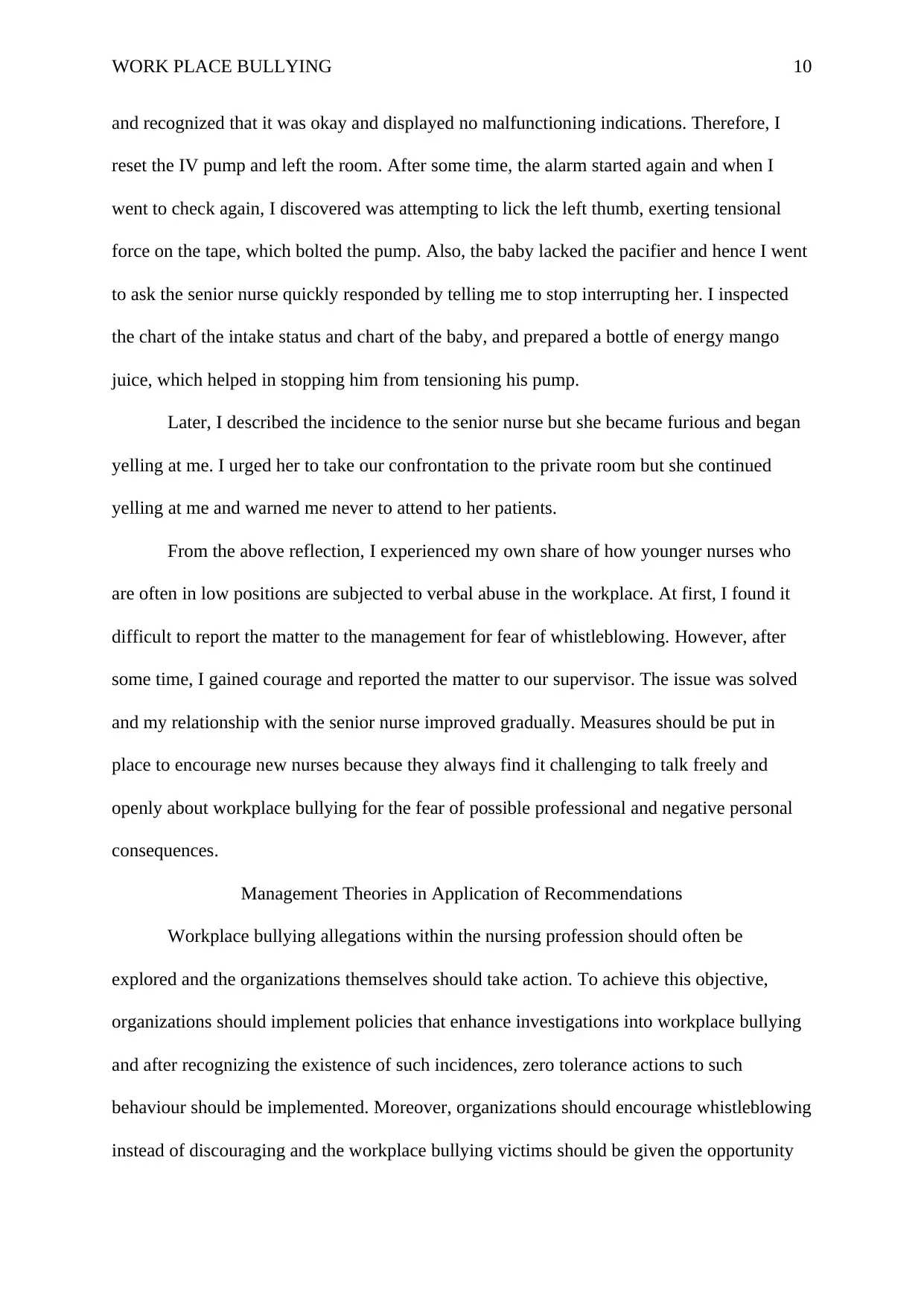
WORK PLACE BULLYING 10
and recognized that it was okay and displayed no malfunctioning indications. Therefore, I
reset the IV pump and left the room. After some time, the alarm started again and when I
went to check again, I discovered was attempting to lick the left thumb, exerting tensional
force on the tape, which bolted the pump. Also, the baby lacked the pacifier and hence I went
to ask the senior nurse quickly responded by telling me to stop interrupting her. I inspected
the chart of the intake status and chart of the baby, and prepared a bottle of energy mango
juice, which helped in stopping him from tensioning his pump.
Later, I described the incidence to the senior nurse but she became furious and began
yelling at me. I urged her to take our confrontation to the private room but she continued
yelling at me and warned me never to attend to her patients.
From the above reflection, I experienced my own share of how younger nurses who
are often in low positions are subjected to verbal abuse in the workplace. At first, I found it
difficult to report the matter to the management for fear of whistleblowing. However, after
some time, I gained courage and reported the matter to our supervisor. The issue was solved
and my relationship with the senior nurse improved gradually. Measures should be put in
place to encourage new nurses because they always find it challenging to talk freely and
openly about workplace bullying for the fear of possible professional and negative personal
consequences.
Management Theories in Application of Recommendations
Workplace bullying allegations within the nursing profession should often be
explored and the organizations themselves should take action. To achieve this objective,
organizations should implement policies that enhance investigations into workplace bullying
and after recognizing the existence of such incidences, zero tolerance actions to such
behaviour should be implemented. Moreover, organizations should encourage whistleblowing
instead of discouraging and the workplace bullying victims should be given the opportunity
and recognized that it was okay and displayed no malfunctioning indications. Therefore, I
reset the IV pump and left the room. After some time, the alarm started again and when I
went to check again, I discovered was attempting to lick the left thumb, exerting tensional
force on the tape, which bolted the pump. Also, the baby lacked the pacifier and hence I went
to ask the senior nurse quickly responded by telling me to stop interrupting her. I inspected
the chart of the intake status and chart of the baby, and prepared a bottle of energy mango
juice, which helped in stopping him from tensioning his pump.
Later, I described the incidence to the senior nurse but she became furious and began
yelling at me. I urged her to take our confrontation to the private room but she continued
yelling at me and warned me never to attend to her patients.
From the above reflection, I experienced my own share of how younger nurses who
are often in low positions are subjected to verbal abuse in the workplace. At first, I found it
difficult to report the matter to the management for fear of whistleblowing. However, after
some time, I gained courage and reported the matter to our supervisor. The issue was solved
and my relationship with the senior nurse improved gradually. Measures should be put in
place to encourage new nurses because they always find it challenging to talk freely and
openly about workplace bullying for the fear of possible professional and negative personal
consequences.
Management Theories in Application of Recommendations
Workplace bullying allegations within the nursing profession should often be
explored and the organizations themselves should take action. To achieve this objective,
organizations should implement policies that enhance investigations into workplace bullying
and after recognizing the existence of such incidences, zero tolerance actions to such
behaviour should be implemented. Moreover, organizations should encourage whistleblowing
instead of discouraging and the workplace bullying victims should be given the opportunity
Secure Best Marks with AI Grader
Need help grading? Try our AI Grader for instant feedback on your assignments.
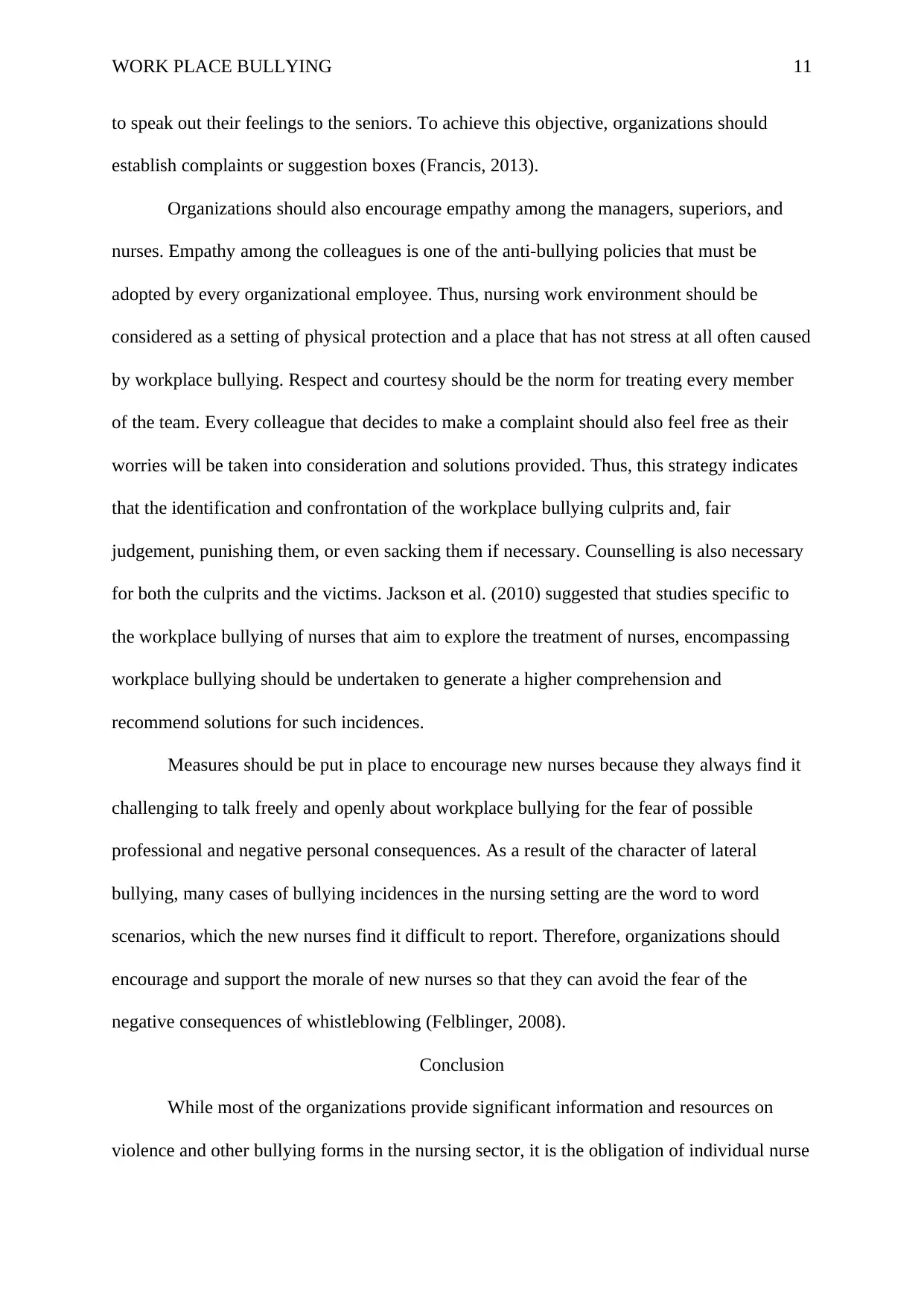
WORK PLACE BULLYING 11
to speak out their feelings to the seniors. To achieve this objective, organizations should
establish complaints or suggestion boxes (Francis, 2013).
Organizations should also encourage empathy among the managers, superiors, and
nurses. Empathy among the colleagues is one of the anti-bullying policies that must be
adopted by every organizational employee. Thus, nursing work environment should be
considered as a setting of physical protection and a place that has not stress at all often caused
by workplace bullying. Respect and courtesy should be the norm for treating every member
of the team. Every colleague that decides to make a complaint should also feel free as their
worries will be taken into consideration and solutions provided. Thus, this strategy indicates
that the identification and confrontation of the workplace bullying culprits and, fair
judgement, punishing them, or even sacking them if necessary. Counselling is also necessary
for both the culprits and the victims. Jackson et al. (2010) suggested that studies specific to
the workplace bullying of nurses that aim to explore the treatment of nurses, encompassing
workplace bullying should be undertaken to generate a higher comprehension and
recommend solutions for such incidences.
Measures should be put in place to encourage new nurses because they always find it
challenging to talk freely and openly about workplace bullying for the fear of possible
professional and negative personal consequences. As a result of the character of lateral
bullying, many cases of bullying incidences in the nursing setting are the word to word
scenarios, which the new nurses find it difficult to report. Therefore, organizations should
encourage and support the morale of new nurses so that they can avoid the fear of the
negative consequences of whistleblowing (Felblinger, 2008).
Conclusion
While most of the organizations provide significant information and resources on
violence and other bullying forms in the nursing sector, it is the obligation of individual nurse
to speak out their feelings to the seniors. To achieve this objective, organizations should
establish complaints or suggestion boxes (Francis, 2013).
Organizations should also encourage empathy among the managers, superiors, and
nurses. Empathy among the colleagues is one of the anti-bullying policies that must be
adopted by every organizational employee. Thus, nursing work environment should be
considered as a setting of physical protection and a place that has not stress at all often caused
by workplace bullying. Respect and courtesy should be the norm for treating every member
of the team. Every colleague that decides to make a complaint should also feel free as their
worries will be taken into consideration and solutions provided. Thus, this strategy indicates
that the identification and confrontation of the workplace bullying culprits and, fair
judgement, punishing them, or even sacking them if necessary. Counselling is also necessary
for both the culprits and the victims. Jackson et al. (2010) suggested that studies specific to
the workplace bullying of nurses that aim to explore the treatment of nurses, encompassing
workplace bullying should be undertaken to generate a higher comprehension and
recommend solutions for such incidences.
Measures should be put in place to encourage new nurses because they always find it
challenging to talk freely and openly about workplace bullying for the fear of possible
professional and negative personal consequences. As a result of the character of lateral
bullying, many cases of bullying incidences in the nursing setting are the word to word
scenarios, which the new nurses find it difficult to report. Therefore, organizations should
encourage and support the morale of new nurses so that they can avoid the fear of the
negative consequences of whistleblowing (Felblinger, 2008).
Conclusion
While most of the organizations provide significant information and resources on
violence and other bullying forms in the nursing sector, it is the obligation of individual nurse
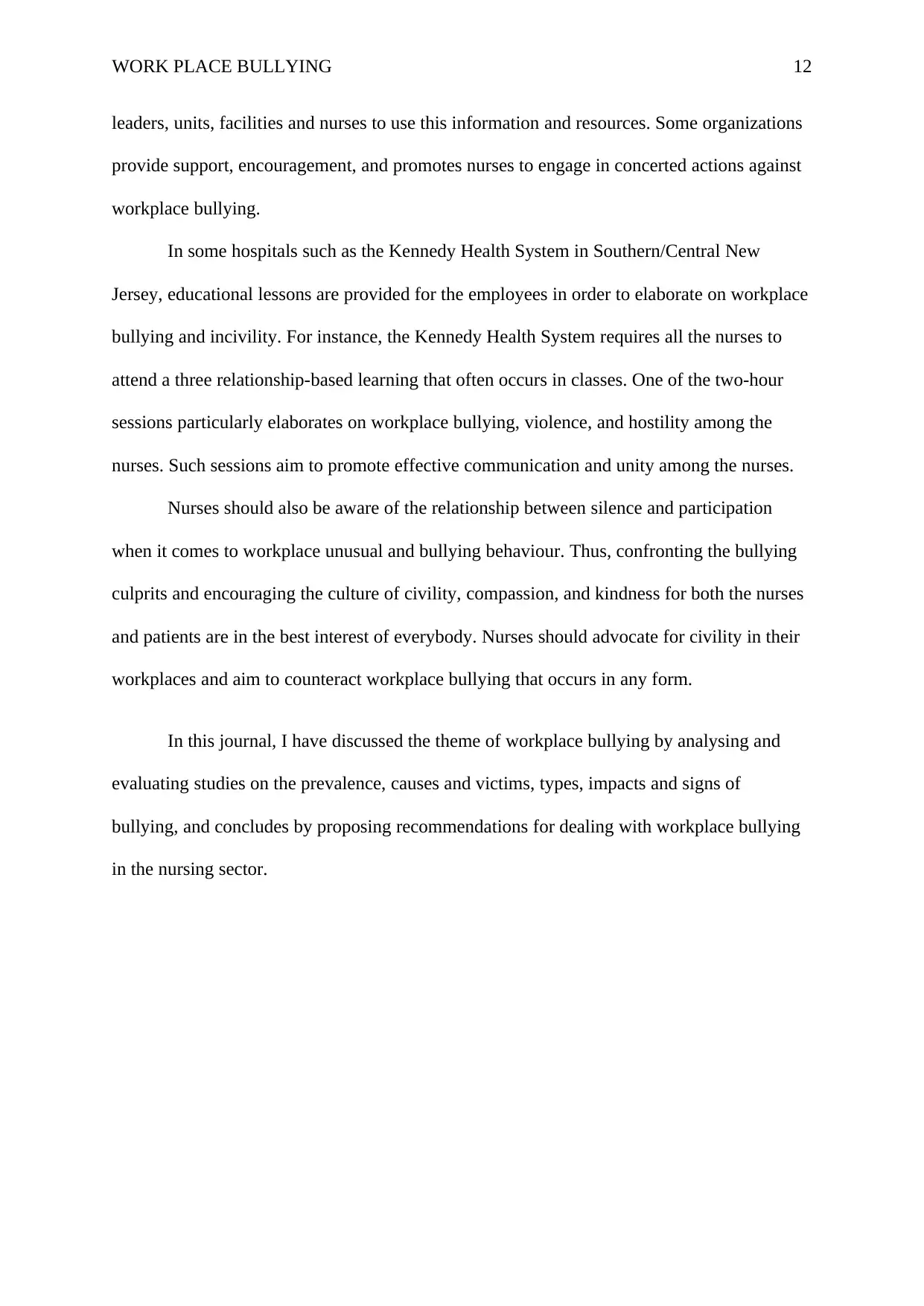
WORK PLACE BULLYING 12
leaders, units, facilities and nurses to use this information and resources. Some organizations
provide support, encouragement, and promotes nurses to engage in concerted actions against
workplace bullying.
In some hospitals such as the Kennedy Health System in Southern/Central New
Jersey, educational lessons are provided for the employees in order to elaborate on workplace
bullying and incivility. For instance, the Kennedy Health System requires all the nurses to
attend a three relationship-based learning that often occurs in classes. One of the two-hour
sessions particularly elaborates on workplace bullying, violence, and hostility among the
nurses. Such sessions aim to promote effective communication and unity among the nurses.
Nurses should also be aware of the relationship between silence and participation
when it comes to workplace unusual and bullying behaviour. Thus, confronting the bullying
culprits and encouraging the culture of civility, compassion, and kindness for both the nurses
and patients are in the best interest of everybody. Nurses should advocate for civility in their
workplaces and aim to counteract workplace bullying that occurs in any form.
In this journal, I have discussed the theme of workplace bullying by analysing and
evaluating studies on the prevalence, causes and victims, types, impacts and signs of
bullying, and concludes by proposing recommendations for dealing with workplace bullying
in the nursing sector.
leaders, units, facilities and nurses to use this information and resources. Some organizations
provide support, encouragement, and promotes nurses to engage in concerted actions against
workplace bullying.
In some hospitals such as the Kennedy Health System in Southern/Central New
Jersey, educational lessons are provided for the employees in order to elaborate on workplace
bullying and incivility. For instance, the Kennedy Health System requires all the nurses to
attend a three relationship-based learning that often occurs in classes. One of the two-hour
sessions particularly elaborates on workplace bullying, violence, and hostility among the
nurses. Such sessions aim to promote effective communication and unity among the nurses.
Nurses should also be aware of the relationship between silence and participation
when it comes to workplace unusual and bullying behaviour. Thus, confronting the bullying
culprits and encouraging the culture of civility, compassion, and kindness for both the nurses
and patients are in the best interest of everybody. Nurses should advocate for civility in their
workplaces and aim to counteract workplace bullying that occurs in any form.
In this journal, I have discussed the theme of workplace bullying by analysing and
evaluating studies on the prevalence, causes and victims, types, impacts and signs of
bullying, and concludes by proposing recommendations for dealing with workplace bullying
in the nursing sector.
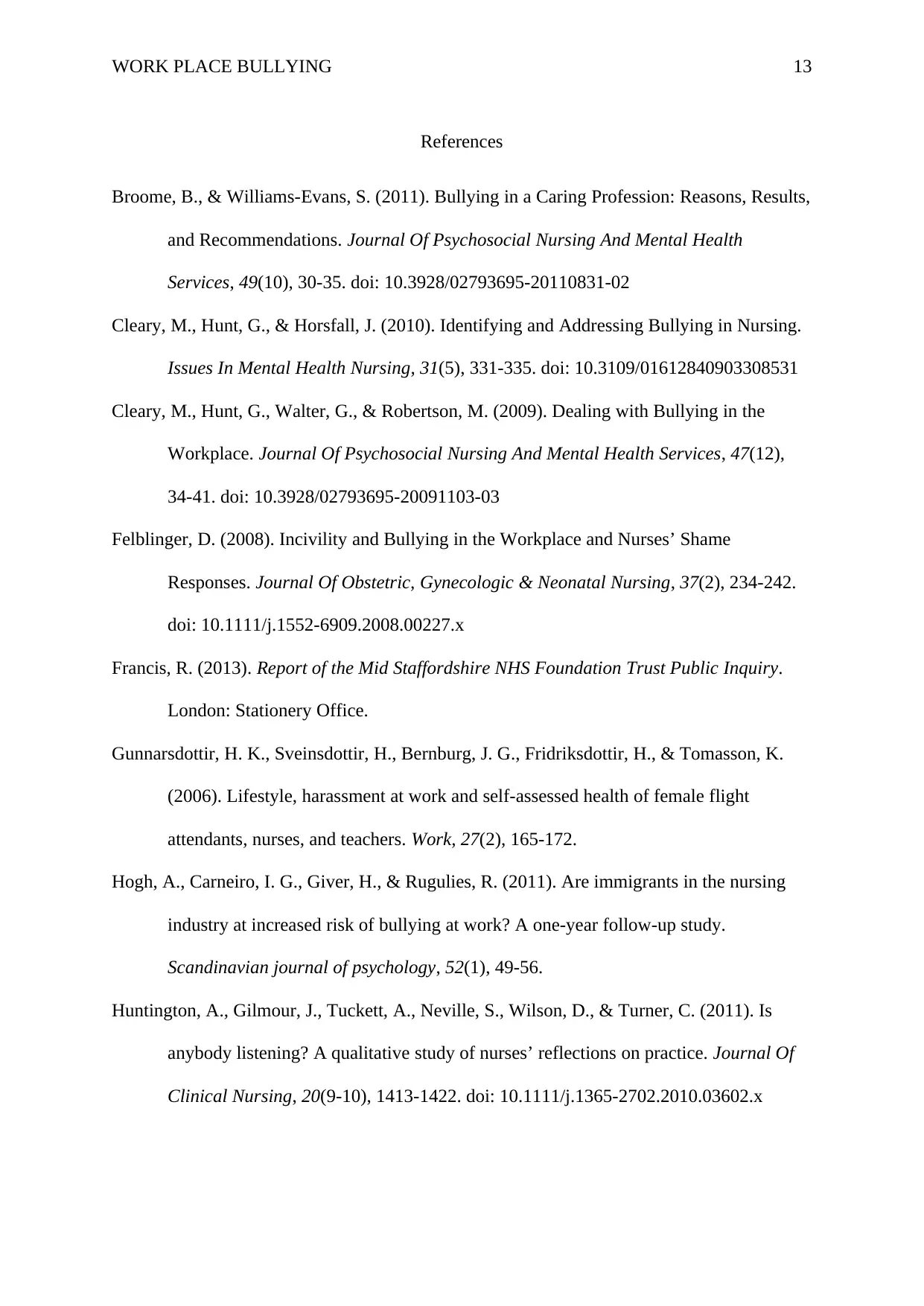
WORK PLACE BULLYING 13
References
Broome, B., & Williams-Evans, S. (2011). Bullying in a Caring Profession: Reasons, Results,
and Recommendations. Journal Of Psychosocial Nursing And Mental Health
Services, 49(10), 30-35. doi: 10.3928/02793695-20110831-02
Cleary, M., Hunt, G., & Horsfall, J. (2010). Identifying and Addressing Bullying in Nursing.
Issues In Mental Health Nursing, 31(5), 331-335. doi: 10.3109/01612840903308531
Cleary, M., Hunt, G., Walter, G., & Robertson, M. (2009). Dealing with Bullying in the
Workplace. Journal Of Psychosocial Nursing And Mental Health Services, 47(12),
34-41. doi: 10.3928/02793695-20091103-03
Felblinger, D. (2008). Incivility and Bullying in the Workplace and Nurses’ Shame
Responses. Journal Of Obstetric, Gynecologic & Neonatal Nursing, 37(2), 234-242.
doi: 10.1111/j.1552-6909.2008.00227.x
Francis, R. (2013). Report of the Mid Staffordshire NHS Foundation Trust Public Inquiry.
London: Stationery Office.
Gunnarsdottir, H. K., Sveinsdottir, H., Bernburg, J. G., Fridriksdottir, H., & Tomasson, K.
(2006). Lifestyle, harassment at work and self-assessed health of female flight
attendants, nurses, and teachers. Work, 27(2), 165-172.
Hogh, A., Carneiro, I. G., Giver, H., & Rugulies, R. (2011). Are immigrants in the nursing
industry at increased risk of bullying at work? A one‐year follow‐up study.
Scandinavian journal of psychology, 52(1), 49-56.
Huntington, A., Gilmour, J., Tuckett, A., Neville, S., Wilson, D., & Turner, C. (2011). Is
anybody listening? A qualitative study of nurses’ reflections on practice. Journal Of
Clinical Nursing, 20(9-10), 1413-1422. doi: 10.1111/j.1365-2702.2010.03602.x
References
Broome, B., & Williams-Evans, S. (2011). Bullying in a Caring Profession: Reasons, Results,
and Recommendations. Journal Of Psychosocial Nursing And Mental Health
Services, 49(10), 30-35. doi: 10.3928/02793695-20110831-02
Cleary, M., Hunt, G., & Horsfall, J. (2010). Identifying and Addressing Bullying in Nursing.
Issues In Mental Health Nursing, 31(5), 331-335. doi: 10.3109/01612840903308531
Cleary, M., Hunt, G., Walter, G., & Robertson, M. (2009). Dealing with Bullying in the
Workplace. Journal Of Psychosocial Nursing And Mental Health Services, 47(12),
34-41. doi: 10.3928/02793695-20091103-03
Felblinger, D. (2008). Incivility and Bullying in the Workplace and Nurses’ Shame
Responses. Journal Of Obstetric, Gynecologic & Neonatal Nursing, 37(2), 234-242.
doi: 10.1111/j.1552-6909.2008.00227.x
Francis, R. (2013). Report of the Mid Staffordshire NHS Foundation Trust Public Inquiry.
London: Stationery Office.
Gunnarsdottir, H. K., Sveinsdottir, H., Bernburg, J. G., Fridriksdottir, H., & Tomasson, K.
(2006). Lifestyle, harassment at work and self-assessed health of female flight
attendants, nurses, and teachers. Work, 27(2), 165-172.
Hogh, A., Carneiro, I. G., Giver, H., & Rugulies, R. (2011). Are immigrants in the nursing
industry at increased risk of bullying at work? A one‐year follow‐up study.
Scandinavian journal of psychology, 52(1), 49-56.
Huntington, A., Gilmour, J., Tuckett, A., Neville, S., Wilson, D., & Turner, C. (2011). Is
anybody listening? A qualitative study of nurses’ reflections on practice. Journal Of
Clinical Nursing, 20(9-10), 1413-1422. doi: 10.1111/j.1365-2702.2010.03602.x
Paraphrase This Document
Need a fresh take? Get an instant paraphrase of this document with our AI Paraphraser
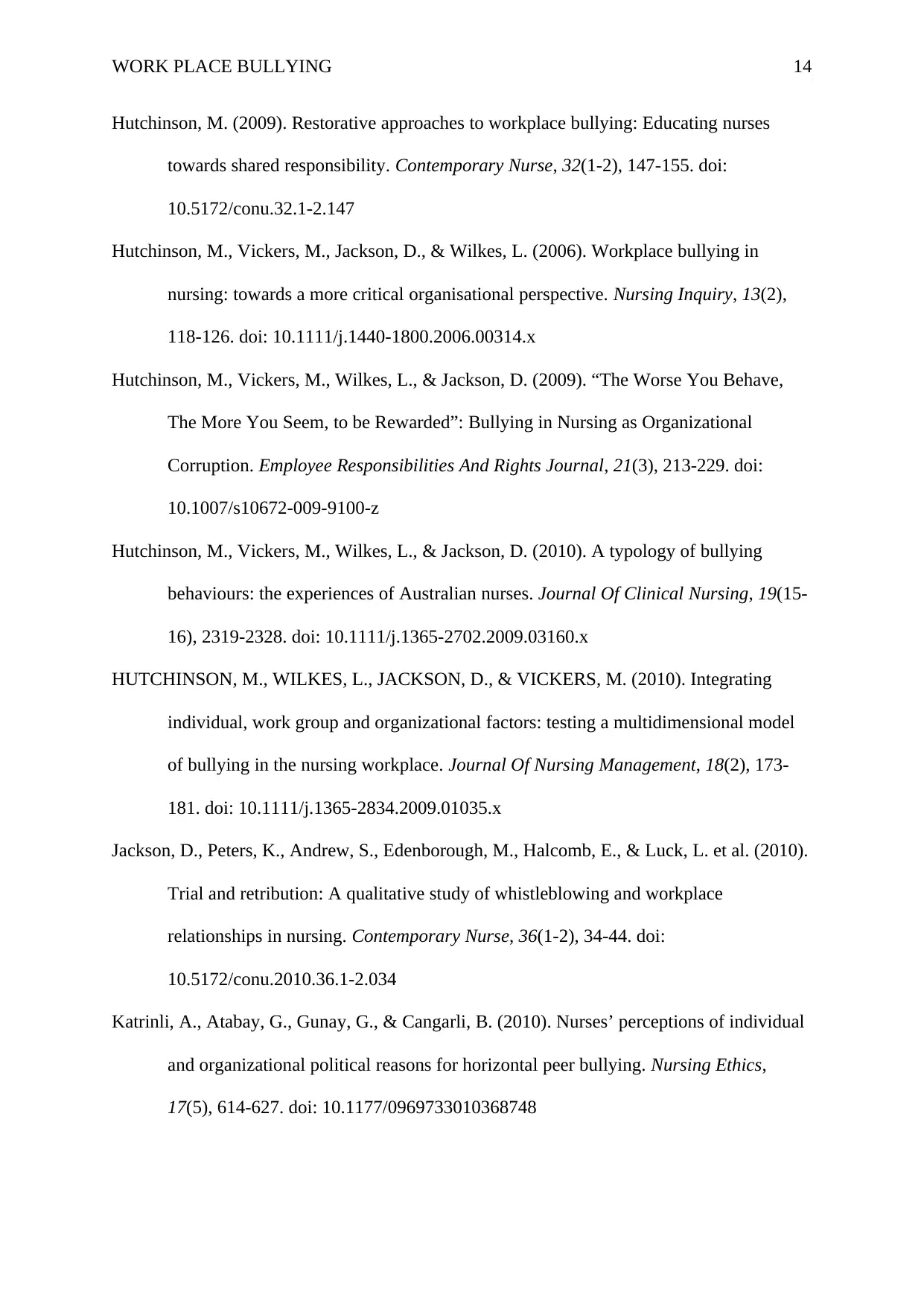
WORK PLACE BULLYING 14
Hutchinson, M. (2009). Restorative approaches to workplace bullying: Educating nurses
towards shared responsibility. Contemporary Nurse, 32(1-2), 147-155. doi:
10.5172/conu.32.1-2.147
Hutchinson, M., Vickers, M., Jackson, D., & Wilkes, L. (2006). Workplace bullying in
nursing: towards a more critical organisational perspective. Nursing Inquiry, 13(2),
118-126. doi: 10.1111/j.1440-1800.2006.00314.x
Hutchinson, M., Vickers, M., Wilkes, L., & Jackson, D. (2009). “The Worse You Behave,
The More You Seem, to be Rewarded”: Bullying in Nursing as Organizational
Corruption. Employee Responsibilities And Rights Journal, 21(3), 213-229. doi:
10.1007/s10672-009-9100-z
Hutchinson, M., Vickers, M., Wilkes, L., & Jackson, D. (2010). A typology of bullying
behaviours: the experiences of Australian nurses. Journal Of Clinical Nursing, 19(15-
16), 2319-2328. doi: 10.1111/j.1365-2702.2009.03160.x
HUTCHINSON, M., WILKES, L., JACKSON, D., & VICKERS, M. (2010). Integrating
individual, work group and organizational factors: testing a multidimensional model
of bullying in the nursing workplace. Journal Of Nursing Management, 18(2), 173-
181. doi: 10.1111/j.1365-2834.2009.01035.x
Jackson, D., Peters, K., Andrew, S., Edenborough, M., Halcomb, E., & Luck, L. et al. (2010).
Trial and retribution: A qualitative study of whistleblowing and workplace
relationships in nursing. Contemporary Nurse, 36(1-2), 34-44. doi:
10.5172/conu.2010.36.1-2.034
Katrinli, A., Atabay, G., Gunay, G., & Cangarli, B. (2010). Nurses’ perceptions of individual
and organizational political reasons for horizontal peer bullying. Nursing Ethics,
17(5), 614-627. doi: 10.1177/0969733010368748
Hutchinson, M. (2009). Restorative approaches to workplace bullying: Educating nurses
towards shared responsibility. Contemporary Nurse, 32(1-2), 147-155. doi:
10.5172/conu.32.1-2.147
Hutchinson, M., Vickers, M., Jackson, D., & Wilkes, L. (2006). Workplace bullying in
nursing: towards a more critical organisational perspective. Nursing Inquiry, 13(2),
118-126. doi: 10.1111/j.1440-1800.2006.00314.x
Hutchinson, M., Vickers, M., Wilkes, L., & Jackson, D. (2009). “The Worse You Behave,
The More You Seem, to be Rewarded”: Bullying in Nursing as Organizational
Corruption. Employee Responsibilities And Rights Journal, 21(3), 213-229. doi:
10.1007/s10672-009-9100-z
Hutchinson, M., Vickers, M., Wilkes, L., & Jackson, D. (2010). A typology of bullying
behaviours: the experiences of Australian nurses. Journal Of Clinical Nursing, 19(15-
16), 2319-2328. doi: 10.1111/j.1365-2702.2009.03160.x
HUTCHINSON, M., WILKES, L., JACKSON, D., & VICKERS, M. (2010). Integrating
individual, work group and organizational factors: testing a multidimensional model
of bullying in the nursing workplace. Journal Of Nursing Management, 18(2), 173-
181. doi: 10.1111/j.1365-2834.2009.01035.x
Jackson, D., Peters, K., Andrew, S., Edenborough, M., Halcomb, E., & Luck, L. et al. (2010).
Trial and retribution: A qualitative study of whistleblowing and workplace
relationships in nursing. Contemporary Nurse, 36(1-2), 34-44. doi:
10.5172/conu.2010.36.1-2.034
Katrinli, A., Atabay, G., Gunay, G., & Cangarli, B. (2010). Nurses’ perceptions of individual
and organizational political reasons for horizontal peer bullying. Nursing Ethics,
17(5), 614-627. doi: 10.1177/0969733010368748
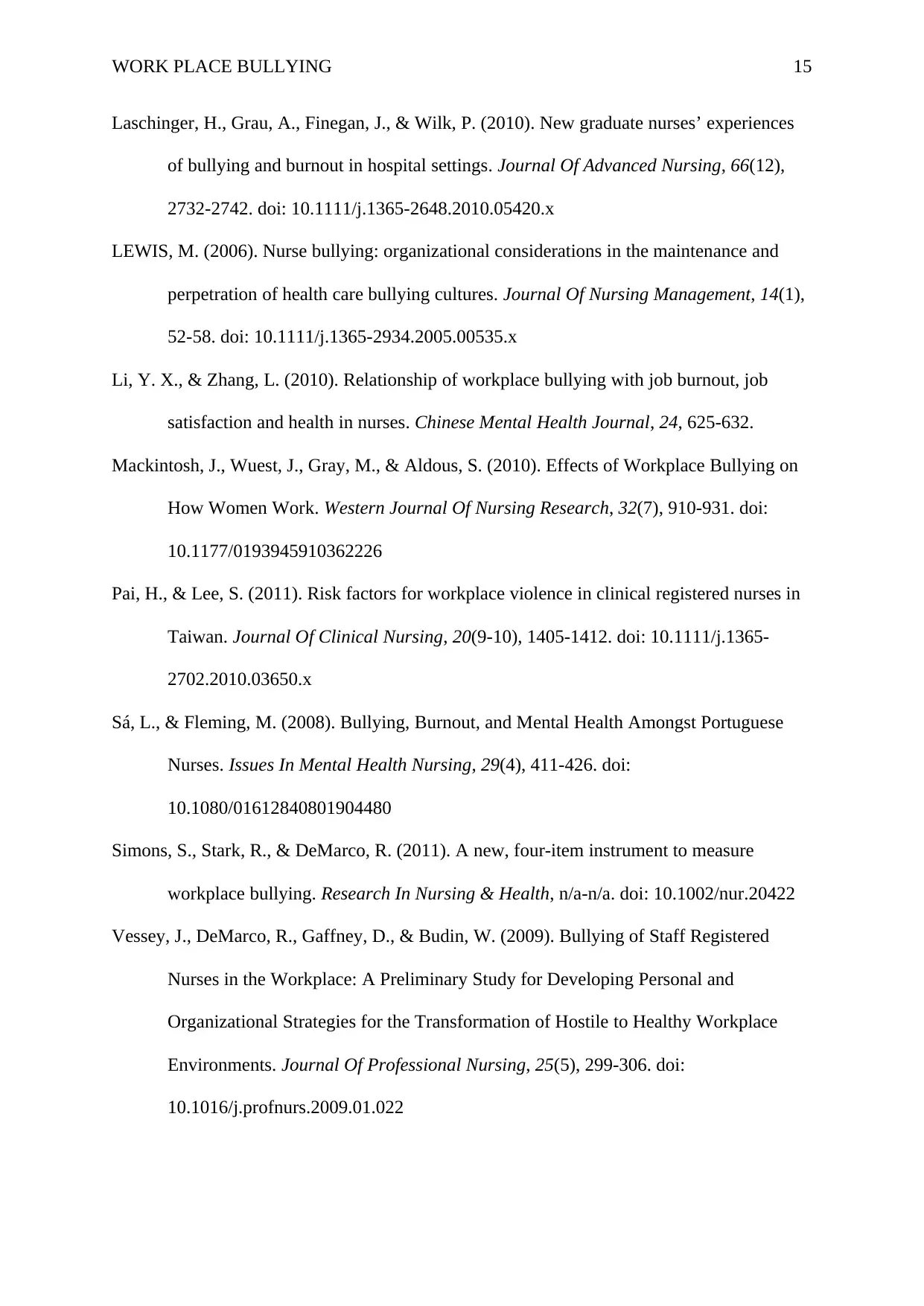
WORK PLACE BULLYING 15
Laschinger, H., Grau, A., Finegan, J., & Wilk, P. (2010). New graduate nurses’ experiences
of bullying and burnout in hospital settings. Journal Of Advanced Nursing, 66(12),
2732-2742. doi: 10.1111/j.1365-2648.2010.05420.x
LEWIS, M. (2006). Nurse bullying: organizational considerations in the maintenance and
perpetration of health care bullying cultures. Journal Of Nursing Management, 14(1),
52-58. doi: 10.1111/j.1365-2934.2005.00535.x
Li, Y. X., & Zhang, L. (2010). Relationship of workplace bullying with job burnout, job
satisfaction and health in nurses. Chinese Mental Health Journal, 24, 625-632.
Mackintosh, J., Wuest, J., Gray, M., & Aldous, S. (2010). Effects of Workplace Bullying on
How Women Work. Western Journal Of Nursing Research, 32(7), 910-931. doi:
10.1177/0193945910362226
Pai, H., & Lee, S. (2011). Risk factors for workplace violence in clinical registered nurses in
Taiwan. Journal Of Clinical Nursing, 20(9-10), 1405-1412. doi: 10.1111/j.1365-
2702.2010.03650.x
Sá, L., & Fleming, M. (2008). Bullying, Burnout, and Mental Health Amongst Portuguese
Nurses. Issues In Mental Health Nursing, 29(4), 411-426. doi:
10.1080/01612840801904480
Simons, S., Stark, R., & DeMarco, R. (2011). A new, four-item instrument to measure
workplace bullying. Research In Nursing & Health, n/a-n/a. doi: 10.1002/nur.20422
Vessey, J., DeMarco, R., Gaffney, D., & Budin, W. (2009). Bullying of Staff Registered
Nurses in the Workplace: A Preliminary Study for Developing Personal and
Organizational Strategies for the Transformation of Hostile to Healthy Workplace
Environments. Journal Of Professional Nursing, 25(5), 299-306. doi:
10.1016/j.profnurs.2009.01.022
Laschinger, H., Grau, A., Finegan, J., & Wilk, P. (2010). New graduate nurses’ experiences
of bullying and burnout in hospital settings. Journal Of Advanced Nursing, 66(12),
2732-2742. doi: 10.1111/j.1365-2648.2010.05420.x
LEWIS, M. (2006). Nurse bullying: organizational considerations in the maintenance and
perpetration of health care bullying cultures. Journal Of Nursing Management, 14(1),
52-58. doi: 10.1111/j.1365-2934.2005.00535.x
Li, Y. X., & Zhang, L. (2010). Relationship of workplace bullying with job burnout, job
satisfaction and health in nurses. Chinese Mental Health Journal, 24, 625-632.
Mackintosh, J., Wuest, J., Gray, M., & Aldous, S. (2010). Effects of Workplace Bullying on
How Women Work. Western Journal Of Nursing Research, 32(7), 910-931. doi:
10.1177/0193945910362226
Pai, H., & Lee, S. (2011). Risk factors for workplace violence in clinical registered nurses in
Taiwan. Journal Of Clinical Nursing, 20(9-10), 1405-1412. doi: 10.1111/j.1365-
2702.2010.03650.x
Sá, L., & Fleming, M. (2008). Bullying, Burnout, and Mental Health Amongst Portuguese
Nurses. Issues In Mental Health Nursing, 29(4), 411-426. doi:
10.1080/01612840801904480
Simons, S., Stark, R., & DeMarco, R. (2011). A new, four-item instrument to measure
workplace bullying. Research In Nursing & Health, n/a-n/a. doi: 10.1002/nur.20422
Vessey, J., DeMarco, R., Gaffney, D., & Budin, W. (2009). Bullying of Staff Registered
Nurses in the Workplace: A Preliminary Study for Developing Personal and
Organizational Strategies for the Transformation of Hostile to Healthy Workplace
Environments. Journal Of Professional Nursing, 25(5), 299-306. doi:
10.1016/j.profnurs.2009.01.022

WORK PLACE BULLYING 16
1 out of 16
Related Documents
Your All-in-One AI-Powered Toolkit for Academic Success.
+13062052269
info@desklib.com
Available 24*7 on WhatsApp / Email
![[object Object]](/_next/static/media/star-bottom.7253800d.svg)
Unlock your academic potential
© 2024 | Zucol Services PVT LTD | All rights reserved.





